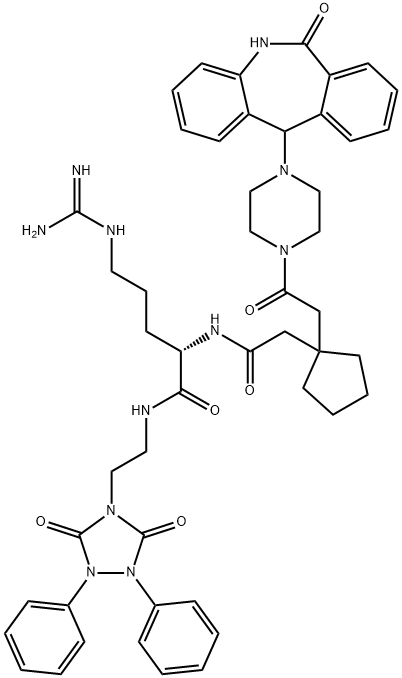246146-55-4
 246146-55-4 結(jié)構(gòu)式
246146-55-4 結(jié)構(gòu)式
基本信息
AR-H 053591
BIIE-0246
BIIE0246
N-[(1S)-4-[(Aminoiminomethyl)amino]-1-[[[2-(3,5-dioxo-1,2-diphenyl-1,2,4-triazolidin-4-yl)ethyl]amino]carbonyl]butyl]-1-
(2S)-5-(diaminomethylideneamino)-N-[2-(3,5-dioxo-1,2-diphenyl-1,2,4-triazolidin-4-yl)ethyl]-2-[[2-[1-[2-oxo-2-[4-(6-oxo-5,11-dihydrobenzo[c][1]benzazepin-11-yl)piperazin-1-yl]ethyl]cyclopentyl]acetyl]amino]pentanamide
N-[(1S)-4-[(Aminoiminomethyl)amino]-1-[[[2-(3,5-dioxo-1,2-diphenyl-1,2,4-triazolidin-4-yl)ethyl]amino]carbonyl]butyl]-1-[2-[4-(6,11-dihydro-6-oxo-5H-dibenz[b,e]azepin-11-yl)-1-piperazinyl]-2-oxoethyl]-cyclopentaneacetamide
Cyclopentaneacetamide, N-[(1S)-4-[(aminoiminomethyl)amino]-1-[[[2-(3,5-dioxo-1,2-diphenyl-1,2,4-triazolidin-4-yl)ethyl]amino]carbonyl]butyl]-1-[2-[4-(6,11-dihydro-6-oxo-5H-dibenz[b,e]azepin-11-yl)-1-piperazinyl]-2-oxoethyl]-
物理化學(xué)性質(zhì)
| 報(bào)價(jià)日期 | 產(chǎn)品編號(hào) | 產(chǎn)品名稱 | CAS號(hào) | 包裝 | 價(jià)格 |
| 2025/02/08 | HY-101986 | BIIE-0246 | 246146-55-4 | 5 mg | 1500元 |
| 2025/02/08 | HY-101986 | BIIE 0246 BIIE-0246 | 246146-55-4 | 10 mM * 1 mLin DMSO | 2366元 |
| 2025/02/08 | HY-101986 | BIIE-0246 | 246146-55-4 | 10 mg | 2400元 |
常見問題列表
|
NPYY 2 receptor 15±3 nM (IC 50 ) |
Receptor binding assays in HEK 293 cells transfected with the rat Y2 receptor cDNA demonstrate that BIIE-0246 competes with high affinity (IC 50 =15±3 nM) against specific [ 125 I]PYY 3-36 binding sites. In contrast, BIIE-0246, at concentrations up to 10 μM, fails to compete for significant amounts of specific [ 125 I]GR231118, [ 125 I]hPP and [ 125 I][Leu 31 , Pro 34 ]PYY binding sites in HEK 293 cells transfected with the rat Y 1 , Y 4 or Y 5 receptor cDNA, respectively.
On chow diet, genetically obese NPY mice show increased gain in body weight and adiposity. Treatment with BIIE-0246 promotes body weight gain in both genotypes after 4.5 weeks, and already at 2 weeks. BIIE-0246 has no significant effect on fat mass gain. In DIO, BIIE-0246 has different effects on body weight and composition depending on the genotype (treatment×genotype interaction in body weight P<0.05, in fat mass P<0.001 and in lean mass P<0.05). In DIO-WT group, post hoc analysis reveals increased body weight and fat mass gain, and a tendency to decrease lean mass gain. In DIO-NPY, BIIE-0246 inhibits fat mass gain (P=0.05). Interestingly, increased cholesterol levels are detected also in WT mice treated with BIIE-0246 for 2 weeks, but not in the 4.5-week cohort. In DIO-NPY mice in both treatment groups, cholesterol levels correlate positively with body fat mass (DIO-NPY vehicle P<0.01; DIO-NPY BIIE-0246 P<0.001), but not in any other group, and the slope of the regression curve of cholesterol and fat mass is significantly decreased in BIIE-0246-treated DIO-NPY group when compared with vehicle-treated group.